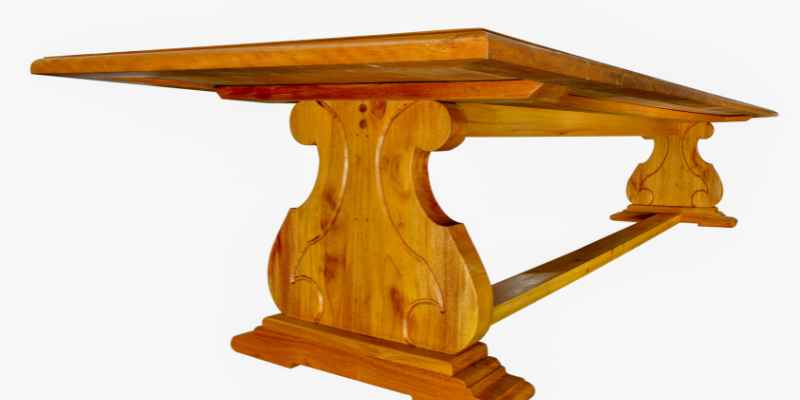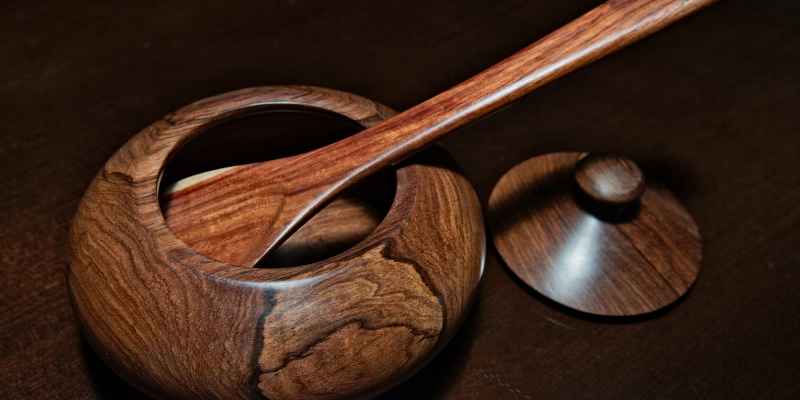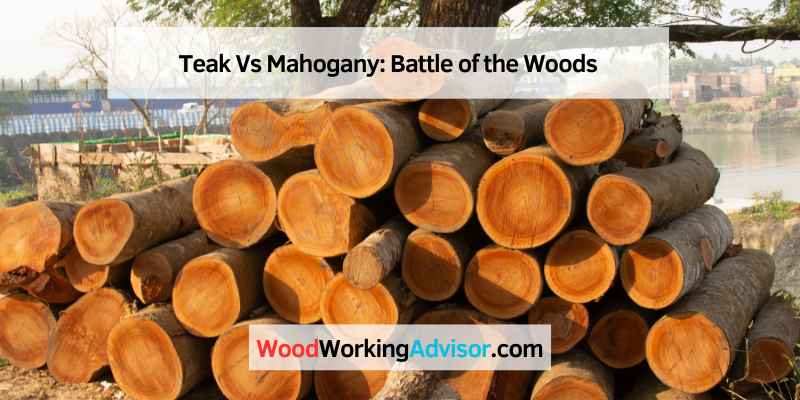Teak and mahogany are highly sought-after woods for furniture due to their durability and aesthetic appeal. The main difference between teak and mahogany lies in their natural characteristics and origin.
Teak wood, native to Southeast Asia, is known for its high oil content and resistance to rot, making it ideal for outdoor furniture. Mahogany, on the other hand, originates from Central and South America, and is prized for its rich color and grain patterns.
Both woods have their own unique qualities, but the choice ultimately depends on personal preferences and the intended use of the furniture. Whether you’re looking for a stunning outdoor patio set or an elegant dining table, understanding the distinctions between teak and mahogany can help you make an informed decision.
Appearance
When choosing the right wood for your furniture or decor, the appearance is a crucial factor that cannot be overlooked. Both teak and mahogany are renowned for their stunning aesthetics, each with its own unique characteristics that can enhance the visual appeal of any space.
Characteristics Of Teak
Teak wood is widely admired for its rich and warm appearance, making it a popular choice for furniture and outdoor decking. Its natural color ranges from golden brown to a deep reddish-brown, imparting an inherent warmth and elegance to any setting.
The wood grain of teak is typically straight and interlocked, giving it a sleek and uniform appearance. This feature enhances the overall aesthetics of teak furniture, creating a refined and polished look that stands the test of time.
Moreover, teak wood develops a unique silver-gray patina over time when exposed to the elements, adding a touch of character and charm to outdoor furniture. This weathered look is highly sought after and is a hallmark of teak’s durability.
Characteristics Of Mahogany
Mahogany wood, on the other hand, boasts a distinctively rich and deep hue that ranges from reddish-brown to dark brown. Its lustrous and smooth surface gives off an air of classic sophistication, making it a popular choice for high-end furniture pieces.
The grain pattern of mahogany can vary, with some boards exhibiting a straight grain, while others showcase a more distinct ribbon-like or interlocking pattern. This unique grain adds depth and visual interest to mahogany furniture, giving it a luxurious and eye-catching appeal.
Notably, mahogany has the ability to develop a beautiful reddish sheen over time, enhancing its overall allure and allure and regal charm. This natural patina enhances the vintage appeal of mahogany furniture, making it a cherished heirloom for generations to come.

Durability
Teak and mahogany are both highly durable woods, but teak is known for its exceptional resistance to rot and decay, making it the preferred choice for outdoor furniture and boats. Mahogany, on the other hand, is prized for its strength and stability, making it a popular option for indoor furniture and high-quality cabinetry.
So, if you’re looking for long-lasting furniture, both teak and mahogany are excellent choices.
Resistance to Termites and Decay
Teak and mahogany are renowned for their durability, making them highly sought-after choices for furniture, decking, and other outdoor applications. When comparing teak and mahogany in terms of durability, it’s important to consider their resistance to termites and decay.
Termites are a common problem that can wreak havoc on wooden structures. However, both teak and mahogany have natural properties that make them unappealing to termites. Teak contains natural oils and resins that act as a deterrent to termites, while mahogany has a dense wood grain that termites find difficult to penetrate.
In terms of resistance to decay, teak and mahogany both excel. Teak is prized for its natural oils, which contain high levels of resin that repel moisture. This natural resistance to moisture makes teak highly resistant to decay, even when exposed to harsh weather conditions. Similarly, mahogany possesses natural oils that provide protection against decay, allowing it to withstand outdoor exposure without succumbing to rot.
Ability to Withstand Environmental Factors
Apart from resistance to termites and decay, the durability of teak and mahogany can also be evaluated based on their ability to withstand environmental factors. Both woods are known for their strength and stability, making them ideal choices for outdoor applications.
Teak is renowned for its exceptional strength, thanks to its tightly packed wood fibers. This inherent strength allows teak furniture and decking to withstand heavy foot traffic, as well as the weight of outdoor furniture and equipment. The stability of teak is further enhanced by its low shrinkage rate, reducing the risk of warping or cracking over time.
Similarly, mahogany is valued for its stability and resilience. Its dense wood grain provides excellent resistance to warping or twisting, even in changing weather conditions. Additionally, mahogany’s high dimensional stability ensures that furniture and structures made from this wood will maintain their shape and structural integrity over time.
In conclusion, both teak and mahogany exhibit impressive durability, making them ideal choices for outdoor applications. Their resistance to termites and decay, as well as their ability to withstand environmental factors, contribute to their long lifespan and continued attractiveness. Whether you opt for teak or mahogany, you can be confident in your choice of a durable and long-lasting wood.
Uses
Teak and mahogany are two popular types of wood known for their durability and aesthetic appeal. While they share some similarities, they also have distinct characteristics that make each wood suitable for specific applications. Understanding the uses of teak and mahogany can help you make an informed decision when it comes to choosing the right wood for your project.
Teak Wood Applications
Teak wood is often referred to as the “king of woods” due to its exceptional qualities and wide range of applications. Its natural oil content makes it highly resistant to moisture, decay, and insect damage, making it an ideal choice for outdoor furniture, boat decks, and other marine applications. Additionally, teak wood’s high strength and durability make it suitable for heavy-duty applications such as construction and flooring.
Here are some common uses of teak wood:
- Outdoor furniture: Teak wood’s natural weather resistance makes it perfect for outdoor furniture such as tables, chairs, and benches. Its beauty and resilience allow it to withstand various weather conditions and retain its appearance for years.
- Boat decks: Teak wood’s inherent grip and resistance to water damage make it a popular choice for boat decks and other marine applications. Its natural oils also prevent the growth of mold and fungi, making it a low-maintenance option.
- Construction: Teak wood’s strength and durability make it suitable for construction purposes such as beams, columns, and flooring. Its resistance to termite attacks and rotting ensures long-lasting structures.
- Flooring: The warm color and natural beauty of teak wood make it a popular choice for flooring, adding elegance and warmth to any space. Its durability and resistance to wear and tear make it suitable for high-traffic areas.
Mahogany Wood Applications
Mahogany wood is prized for its rich color, unique grain patterns, and durability. It is known for its stability and resistance to shrinking and warping, making it ideal for a wide range of applications. While mahogany is commonly associated with luxurious furniture, its uses extend beyond woodwork.
Here are some common uses of mahogany wood:
- Indoor furniture: Mahogany’s warm reddish-brown hue and straight grains make it a popular choice for high-quality furniture such as tables, cabinets, and chairs. Its ability to age gracefully adds value and sophistication to any interior space.
- Doors and windows: Mahogany wood’s stability and resistance to changes in moisture levels make it an excellent choice for doors and windows. Its natural beauty enhances the overall aesthetics of a property.
- Musical instruments: The excellent resonance and tonal qualities of mahogany make it a preferred wood for crafting musical instruments such as guitars and pianos. Its durability ensures that instruments produced from mahogany can withstand regular use and maintain their sound quality over time.
- Veneer and paneling: Mahogany wood’s attractive figuring and grain patterns make it a popular choice for veneers, paneling, and decorative trims. Its ability to be easily worked and finished allows for intricate designs and details.
Price And Availability
When considering the difference between teak and mahogany, one important factor to consider is their price and availability. Both teak and mahogany are highly valued for their quality, durability, and beauty, but they differ in terms of cost and accessibility.
Comparing The Cost Of Teak And Mahogany
To understand the cost comparison between teak and mahogany, let’s take a closer look at some key factors:
| Teak | Mahogany |
|---|---|
| Known for its exceptional quality and natural resistance to decay, teak is highly sought after in the furniture industry. | Mahogany is also prized for its strength and beautiful reddish-brown hue, making it a popular choice for furniture and interior design. |
| Due to its scarcity and demand, teak tends to be more expensive compared to mahogany. | Mahogany, on the other hand, is more readily available which makes it relatively more affordable. |
| Teak’s higher price is also influenced by factors such as its slow growth rate, limited supply, and sustainable harvesting practices. | While mahogany is more accessible, prices can still vary depending on the species and quality of the wood. |
Accessibility And Sustainability
Accessibility and sustainability are crucial considerations when it comes to choosing between teak and mahogany:
- Teak: Teak trees grow in tropical regions such as Southeast Asia, primarily in countries like Indonesia, Myanmar, and India. Due to its limited natural resources, obtaining teak wood can be challenging and, as a result, it tends to command higher prices. However, teak is known for its sustainability, as responsible forestry practices and tree plantation programs ensure its continued availability.
- Mahogany: Mahogany trees are native to various regions around the world, including Central America, South America, and Africa. They are more easily accessible and widely cultivated, resulting in greater affordability. Nonetheless, it is important to source mahogany from sustainable and well-managed forests to protect these valuable ecosystems.
In conclusion, while both teak and mahogany offer exceptional qualities as hardwoods, their price and availability greatly differ. Teak tends to be pricier due to its limited supply and high demand, while mahogany is more accessible and affordable. Ultimately, the choice between the two will depend on your specific needs, budget, and sustainability considerations.

Frequently Asked Questions On Teak Vs Mahogany
Which Is Best Teak Or Mahogany?
Teak and mahogany are both popular choices for furniture, but teak is superior due to its durability, resistance to weather and pests, and beautiful grain. Teak is also more expensive than mahogany, but it offers better overall quality.
Which Wood Is Better Than Teak?
Teak is known for its quality, but there are other woods that can be better depending on your needs. For outdoor use, cedar and mahogany are excellent choices. For indoor furniture, oak and walnut offer durability and beauty. Consider the specific application and preferences for the best wood.
What Are The Disadvantages Of Mahogany Wood?
Mahogany wood has a few drawbacks. It can be expensive, making it less accessible for some. It may also be prone to warping and shrinking with changes in humidity. Additionally, mahogany trees are harvested at unsustainable rates, leading to deforestation and loss of biodiversity.
Is Mahogany A Luxury Wood?
Yes, mahogany is considered a luxury wood due to its rich, dark color, durability, and natural beauty. Its high-quality and sought-after characteristics make it a preferred choice for luxurious furniture, flooring, and decorative items.
Conclusion
Ultimately, choosing between teak and mahogany depends on your specific needs and preferences. Both woods offer exceptional durability, beauty, and versatility for furniture and other applications. Consider the unique qualities of each wood, such as teak’s natural oil content or mahogany’s rich reddish-brown hue, to make an informed decision.
Whether you prioritize longevity or aesthetics, both teak and mahogany are excellent choices that will enhance your space for years to come.


